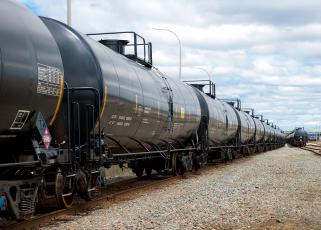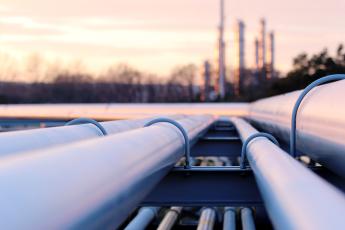Last month Rob Benedict, senior director, petrochemicals, transportation and infrastructure at AFPM, spoke with Railway Age Editor-in-Chief William C. Vantuono regarding a host of current issues facing AFPM members and freight rail shippers across the United States. The discussion included current safety, regulatory and legislative topics that will shape the U.S. freight rail industry in the years ahead.
Q: How is the COVID-19 pandemic impacting your industry?
Rob Benedict: Our industries are dependent on well-functioning supply chains. We use all modes of transportation – pipelines, waterways, trucking – and we rely very much on rail. In a typical year, we ship millions and millions of rail carloads. Because we represent both U.S. refiners and petrochemical manufacturers, we’re talking not only about moving feedstocks to our plants, such as crude oil and natural gas liquids (NGL), but also about moving the refined and finished products to market. So again, a healthy and safe rail industry is very important to us.
Nobody has been spared from COVID-19. Rail traffic is down across the board, and we’re seeing record low movement on rail amongst our members. But they are eager to bounce back, and we look forward to seeing what that looks like in the coming weeks and months.
Q: Traffic for both fuel and petrochemicals is down – is this a double whammy for your industries?
RB: It’s certainly true that we’ve felt some impacts. Some petrochemicals used in food safety and in the medical arena are doing well, whereas others that are used in the automobile and construction sectors are currently taking a hit. Bottom line: we’re confident that our industries will bounce back along with others given the right measures. And we’re looking forward to seeing the rail sector bounce back as well.
Q: The Federal Railroad Administration (FRA) is looking at easing some safety requirements. Could you share your comments about what’s happening there?
RB: Rail safety is a huge issue for our members. In fact, our members are in the middle of an upgrade of the entire rail tank car fleet. We are buying and retrofitting our cars to the newest and safest tank car standard, the DOT-117J and 117R tank cars. Our members are paying for that investment – between 2013 and 2019 they bought or retrofitted 65,000 of the 117J and 117R tank cars. This is doing a lot to reduce risk.
Regarding your specific question, the Federal Railroad Administration (FRA) offers waivers for safety-related functions during times of crisis like this and has opened a docket for COVID-19, and they’re giving shippers the opportunity to comment. Nothing has jumped out to our members that we’ve felt we needed to flag, but we have a process to do that if needed and appreciate the opportunity to provide input on rail safety issues.
More broadly, our members are interested in addressing “root cause” to prevent derailments. The railroads have done a lot to enhance safety, but we think we can do more. We also were encouraged by the U.S. Department of Transportation’s (DOT) recent announcement that, based on the new report from the U.S. Department of Energy (DOE) and Sandia National Laboratories, they’ve pulled back their intent to regulate vapor pressure in rail transport. This is no small thing, and we’re certainly encouraged by this action.
Q: What are the railroads saying about the Sandia study?
RB: I can’t speak for the railroads, but I know they are also encouraged by a robust and data-driven process. Both the railroads and the rail shippers want any regulation to be data-driven, and with that extensive report from DOE, I would imagine the railroads are encouraged by the process too. This is a good example of the way the rulemaking process should work. Overall, it’s worth noting that both the rail shippers and the railroads have made significant investments to improve safety and reduce risk in the U.S. rail system.
Q: Let’s talk about regulatory reform and what you’re focused on.
RB: As you may be aware, the Surface Transportation Board, or STB, regulates a lot of the economic aspects of rail, and they were busy this last fall with a number of proposals, the most notable of these related to demurrage and accessorial fees. Just a few weeks ago, STB released a policy statement regarding how they will look at these fees. They also released a supplemental rulemaking looking at how such fees are charged and communicated.
We’re also looking at rate reform in a broader sense and the proper adjudication of rail rate cases. The time required for such cases has often been so long that taking rate cases to STB hasn’t been practical. STB also released a rule regarding arbitration, somewhat along the lines of the baseball style of arbitration, and we’ve commented on that as well.
Q: Can you talk about trains that are potentially storing crude?
RB: As far as crude rail storage goes, it’s definitely become an issue, though a bit more of an upstream one. Rail storage has been a difficult thing to do, because you’re at the nexus of private and public tracks, multiple regulatory agency jurisdictions between the Environmental Protection Agency and DOT, etc. Frankly, this hasn’t been a top-of-mind issue for our refining and petrochemical members at the moment. It’s something that the crude producers are more focused on.
Q: Regarding safety and preventing derailments, let’s talk about root cause. Is there a specific process that you may have in mind to determine root cause?
RB: When we talk about root cause, we’re really talking about eliminating derailments in the first place. This touches on some open regulatory actions, but also potential actions that could be taken. FRA is currently looking at this – they have a rule out on track integrity standards that would allow for more frequent track inspections. The railroads are also in favor of testing track more, and I think we should find a regulatory scheme allowing us to do that.
There’s also discussion at the Pipeline and Hazardous Materials Safety Administration (PHMSA) about putting more wayside detectors in place so that we can know better where shipments are and also do diagnostics on the tracks. This type of technology has the opportunity to not only improve safety, but to improve efficiency, which is really a win all around.
Q: In terms of working with the rail industry, is there a select group of industry experts willing to sit down with FRA and dive into safety a bit more?
RB: AFPM is always open to discussions to improve the safety and efficiency of the rail network. We see a few avenues for this. FRA just announced that the Rail Safety Advisory Committee is being reconstituted, and we’re excited about that. AFPM also has observer status on the AAR tank car committee, which has been productive. And we frequently talk with the railroads and rail suppliers such as the Rail Supply Institute. We don’t always agree on everything, but we maintain good relationships. Ultimately we’re all driving toward the same goal, which is zero incidents.


